Grid computing is the use of widely distributed computer resources to reach a common goal. A computing grid can be thought of as a distributed system with non-interactive workloads that involve many files. Grid computing is distinguished from conventional high-performance computing systems such as cluster computing in that grid computers have each node set to perform a different task/application. Grid computers also tend to be more heterogeneous and geographically dispersed than cluster computers. Although a single grid can be dedicated to a particular application, commonly a grid is used for a variety of purposes. Grids are often constructed with general-purpose grid middleware software libraries. Grid sizes can be quite large.
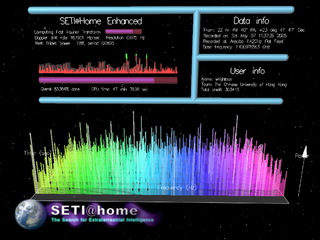
SETI@home is a project of the Berkeley SETI Research Center to analyze radio signals, searching for signs of extraterrestrial intelligence. Until March 2020, it was run as an Internet-based public volunteer computing project that employed the BOINC software platform. It is hosted by the Space Sciences Laboratory at the University of California, Berkeley, and is one of many activities undertaken as part of the worldwide SETI effort.

The Berkeley Open Infrastructure for Network Computing is an open-source middleware system for volunteer computing. Developed originally to support SETI@home, it became the platform for many other applications in areas as diverse as medicine, molecular biology, mathematics, linguistics, climatology, environmental science, and astrophysics, among others. The purpose of BOINC is to enable researchers to utilize processing resources of personal computers and other devices around the world.
Predictor@home was a volunteer computing project that used BOINC. It was established by The Scripps Research Institute to predict protein structure from protein sequence in the context of the 6th biannual CASP, or Critical Assessment of Techniques for Protein Structure Prediction. A major goal of the project was the testing and evaluating of new algorithms to predict both known and unknown protein structures. The project was most recently run by the University of Michigan.

LHC@home is a volunteer computing project for particle physics based on the Berkeley Open Infrastructure for Network Computing (BOINC) platform. The project's computing power is utilized by physicists at CERN in support of the Large Hadron Collider and other experimental particle accelerators.
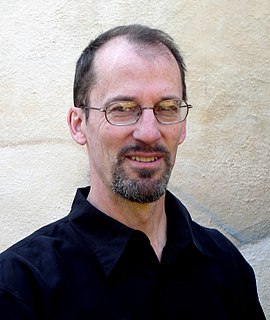
David Pope Anderson is an American research scientist at the Space Sciences Laboratory, at the University of California, Berkeley, and an adjunct professor of computer science at the University of Houston. Anderson leads the SETI@home, BOINC, Bossa and Bolt software projects.

Rosetta@home is a volunteer computing project for protein structure prediction on the Berkeley Open Infrastructure for Network Computing (BOINC) platform, run by the Baker laboratory at the University of Washington. Rosetta@home aims to predict protein–protein docking and design new proteins with the help of about fifty-five thousand active volunteered computers processing at over 487,946 GigaFLOPS on average as of September 19, 2020. Foldit, a Rosetta@home videogame, aims to reach these goals with a crowdsourcing approach. Though much of the project is oriented toward basic research to improve the accuracy and robustness of proteomics methods, Rosetta@home also does applied research on malaria, Alzheimer's disease, and other pathologies.
Africa@home is a website that allow users to use their home computers to contribute for humanitarian causes at Africa. This project first went public on 13 July 2006. It partners with Swiss Tropical Institute, the University of Geneva, CERN, and International Conference Volunteers (ICV). It is sponsored by the Geneva International Academic Network (GIAN).
Similarity Matrix of Proteins (SIMAP) is a database of protein similarities created using volunteer computing. It is freely accessible for scientific purposes. SIMAP uses the FASTA algorithm to precalculate protein similarity, while another application uses hidden Markov models to search for protein domains. SIMAP is a joint project of the Technical University of Munich, the Helmholtz Zentrum München, and the University of Vienna.

SETI@home beta, is a hibernating volunteer computing project using the Berkeley Open Infrastructure for Network Computing (BOINC) platform, as a test environment for future SETI@home projects:
HashClash was a volunteer computing project running on the Berkeley Open Infrastructure for Network Computing (BOINC) software platform. to find collisions in the MD5 hash algorithm. It was based at Department of Mathematics and Computer Science at the Eindhoven University of Technology, and Marc Stevens initiated the project as part of his master's degree thesis.
Volunteer computing is a type of distributed computing in which people donate their computers' unused resources to a research-oriented project, and sometimes in exchange for credit points. The fundamental idea behind it is that a modern desktop computer is sufficiently powerful to perform billions of operations a second, but for most users only between 10-15% of its capacity is used. Typical uses like basic word processing or web browsing leave the computer mostly idle.

ABC@Home was an educational and non-profit network computing project finding abc-triples related to the abc conjecture in number theory using the Berkeley Open Infrastructure for Network Computing (BOINC) volunteer computing platform.

Ibercivis was a volunteer computing platform which allows internet users to participate in scientific research by donating unused computer cycles to run scientific simulations and other tasks. The original project, which became operational in 2008, was a scientific collaboration between the Portuguese and Spanish governments, but it is open to the general public and scientific community, both within and beyond the Iberian Peninsula. The project's name is a portmanteau of Iberia and the Latin word civis, meaning 'citizen'.

AQUA@home was a volunteer computing project operated by D-Wave Systems that ran on the Berkeley Open Infrastructure for Network Computing (BOINC) software platform. It ceased functioning in August 2011. Its goal was to predict the performance of superconducting adiabatic quantum computers on a variety of problems arising in fields ranging from materials science to machine learning. It designed and analyzed quantum computing algorithms, using Quantum Monte Carlo techniques.
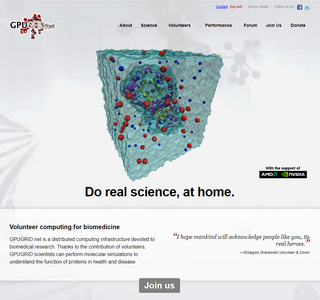
GPUGRID is a volunteer computing project hosted by Pompeu Fabra University and running on the Berkeley Open Infrastructure for Network Computing (BOINC) software platform. It performs full-atom molecular biology simulations that are designed to run on Nvidia's CUDA-compatible graphics processing units.

Docking@Home was a volunteer computing project hosted by the University of Delaware and running on the Berkeley Open Infrastructure for Network Computing (BOINC) software platform. It models protein-ligand docking using the CHARMM program. The ultimate aim was the development of new pharmaceutical drugs.
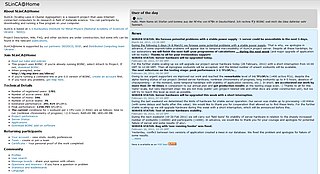
SLinCA@Home was a research project that uses Internet-connected computers to do research in fields such as physics and materials science.
OProject@Home was a volunteer computing project running on the Berkeley Open Infrastructure for Network Computing (BOINC) and was based on a dedicated library OLib. The project was directed by Lukasz Swierczewski, an IT student at the College of Computer Science and Business Administration in Łomża, Computer Science and Automation Institute. As of 2016 it seems to have been abandoned.
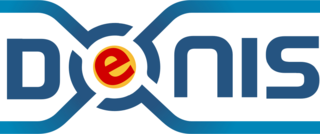
DENIS@Home is a volunteer computing project hosted by Universidad San Jorge (Zaragoza,Spain) and running on the Berkeley Open Infrastructure for Network Computing (BOINC) software platform.













